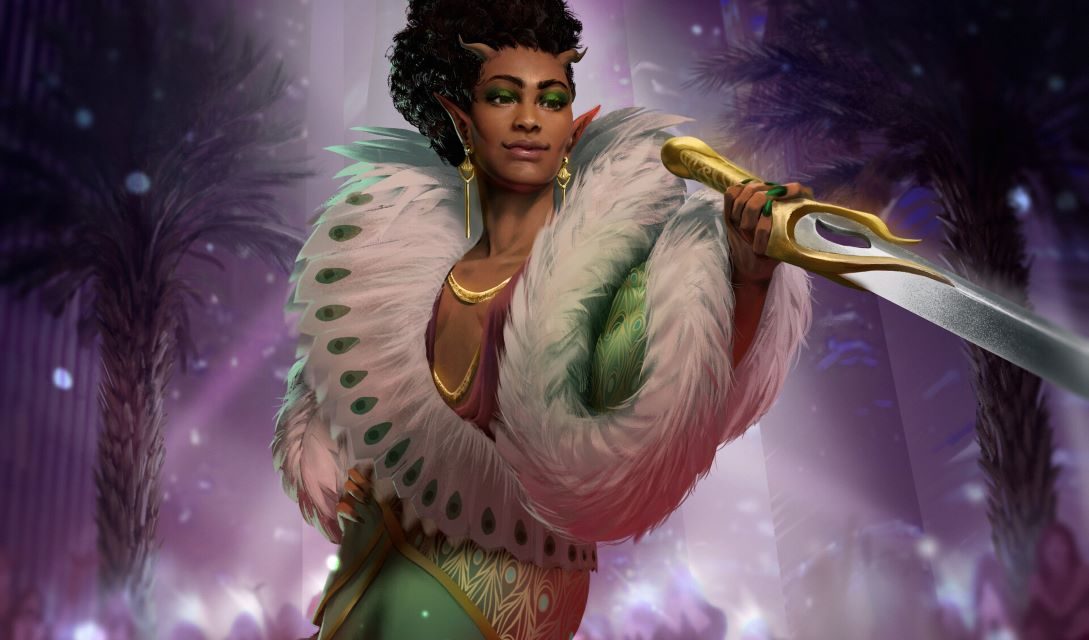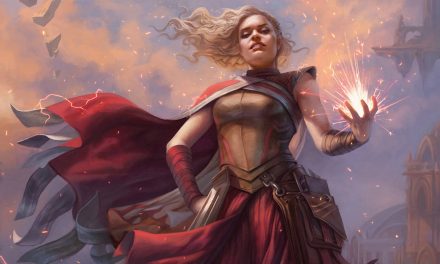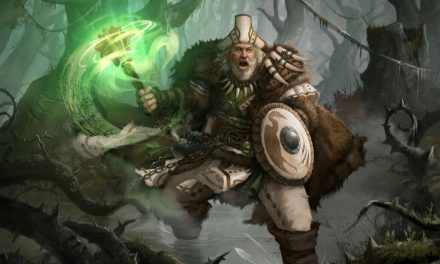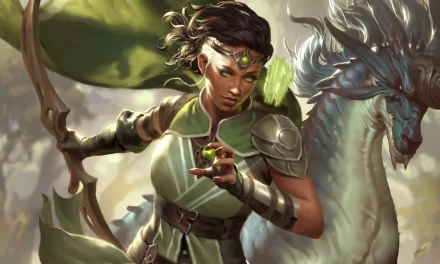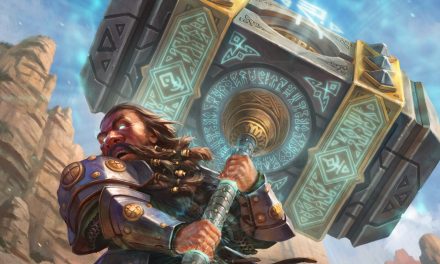Blending elegant dance, expert swordplay, and arcane magic, the Bladesinger Wizard is a sight to behold!
To master this ancient Elven tradition takes a considerable amount of knowledge, training, and experience. But those who make the cut and become Bladesingers stand among a proud few elite warriors who are widely known for their prowess on and off the battlefield.
Are you ready to become a part of this ancient and exclusive tradition?
Now is your chance.
This is the full guide to the Bladesinger Wizard in D&D 5e!
What is the Bladesinger Wizard in D&D 5e?
When you think of Wizards, dancing and swordplay probably aren’t the first things that come to mind.
However, this blend of precise and elegant movements combined with arcane knowledge creates a unique arcane tradition that is both visually stunning and effective!
Bladesinger Wizards find the roots of their tradition in Elven culture, and this tradition was historically VERY closely guarded. To even be considered for training in the art of Bladesinging, one had to be an Elf or Half-Elf.
However, it has opened up more over the years.
Now, both Elves and non-Elves who can commit to such mastery of their minds and bodies are able to be recognized as Bladesingers.
Though rest assured, it’s no easy title to gain!
You can find the Bladesinger Wizard in Tasha’s Cauldron of Everything.
While the Bladesinger option was published prior to the release of TCoE, this most recent publication does make some important changes to the subclass. As such, this updated version is what we’ll be referencing for this guide!
Role in the Party
When it comes to the Bladesinger Wizard’s role in the party, these characters wear several hats. It becomes a bit of a juggling act that can honestly be somewhat intimidating.
As a Bladesinger, you’re still a Wizard, first and foremost. This means that you’ve got access to the biggest spell list in the game and a ton of options for what your go-to spells are.
We’ll touch on Bladesinger styles later in this guide which can give you some extra guidance on how your Bladesinger might function. Additionally, I’ll be publishing a guide to Bladesinger spells very soon, which should give you some extra help.
But it’s important to note that your spell selection is absolutely vital. You definitely want to grab spells that improve your combat performance or lock enemies down. However, you shouldn’t ignore AoE spell options and the incredibly handy utility spells on your spell list.
There’s a certain major temptation to view the Bladesinger’s role as being offensive. And, sure, these characters absolutely can go on the offensive when they need to.
However, the Bladesinger’s features and improvements to their melee combat abilities (combined with the Wizard class’s small hit die) actually lend themselves better towards a more defensive role.
Clever spell use is the key to the Bladesinger’s ability to fill their role, but they can certainly hold their own in melee combat if things get tight.
To that end, their Bladesong and melee abilities can work wonderfully when you need to go on the defensive, turn up the pressure, and lead a counterattack against your foes.
Bladesingers juggle the responsibilities of melee combat, blasting, and arcane utility. While the exact ratio of each will depend heavily on your party composition, you will need to stay flexible and strategic!
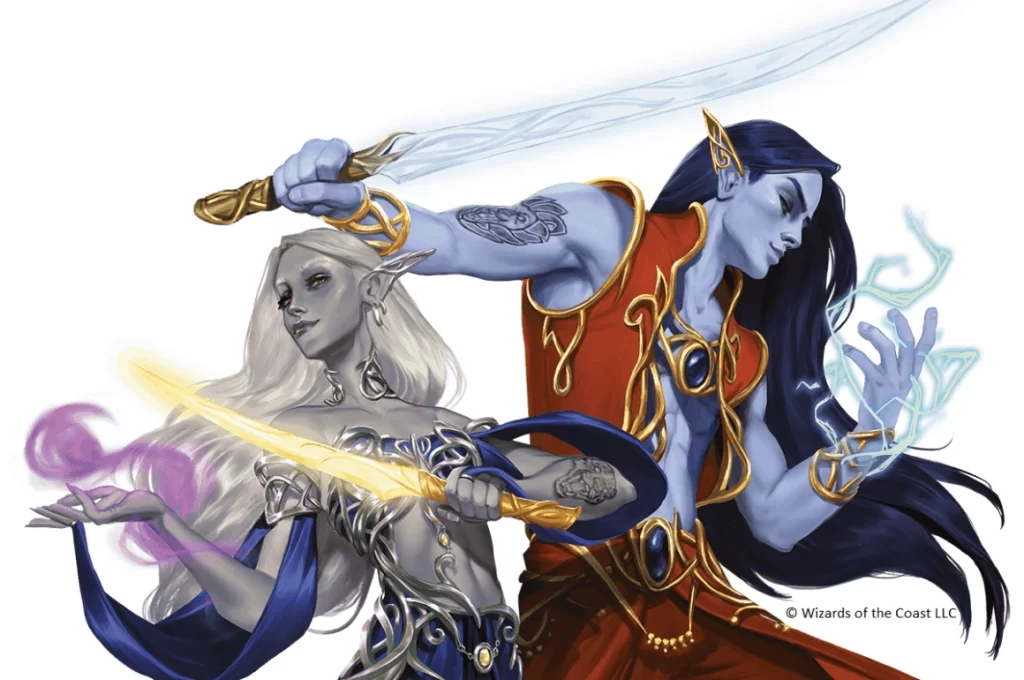
Bladesinger Wizard Features 5e
Alright, so now that we’ve covered the broad strokes of what the Bladesinger Wizard is, let’s get into the features.
You won’t be gaining any features that really affect how your spellcasting works. Instead, the focus of these features is on helping the Bladesinger be better equipped to hold their own in melee combat.
With that said, let’s get into it!
Recommended: Using and Managing the Wizard’s Spellbook
Trained in War and Song (Level 2)
Kicking things off, you’re going to need some extra proficiencies if you want to stand on the party’s front lines.
After all, robes don’t exactly offer much in the way of protection!
Sure, they’re fine for most Wizards. But you aren’t most Wizards!
You’re a Bladesinger, baby!
You gain proficiency with light armor, and you gain proficiency with one type of one-handed melee weapon of your choice.
You also gain proficiency in the Performance skill if you don’t already have it.
Gaining proficiency with light armor is great for keeping your insides… well… inside!
Sure, there’s always the classic Mage Armor to help you out. However, gaining proficiency with light armor is very helpful for freeing up that spell slot each day!
You can certainly choose to use Mage Armor instead (which will give you slightly more AC), but it’s nice to have options.
Now, as for your weapons…
It’s not surprising that Wizards don’t exactly have a stellar list of weapon proficiencies. Thankfully, you’ve got your choice of several one-handed weapons that you can gain proficiency with now.
While the longsword tends to get most of the credit, I’m much more partial to a Dexterity build for Bladesingers.
You already need to juggle your Intelligence (for spells), Constitution (for health and concentration), and Dexterity (for your armor class). Why add Strength to the mix?
To that end, I recommend using a finesse weapon.
Rapiers are excellent options, but you might also enjoy using a shortsword or scimitar. If you want some extra reach, a whip is also an interesting option to consider.
As for your Performance proficiency, it’s some fun flavor.
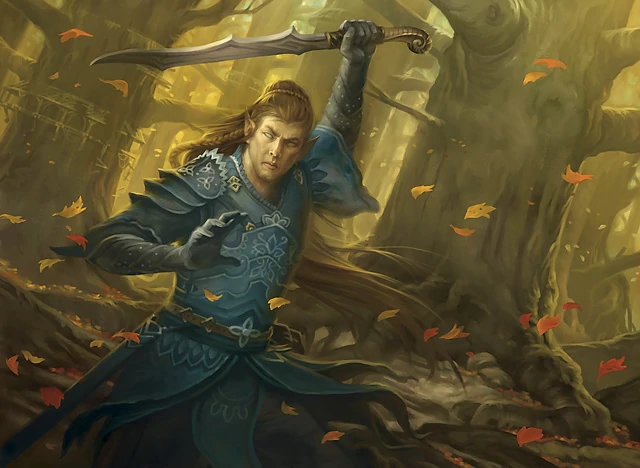
Bladesong (Level 2)
In addition to the proficiencies you gained with your other level 2 feature, you’ll also be gaining the Bladesinger’s most important feature at level 2.
This is a powerful buff that makes it much easier for you to hold your own in melee combat.
You can invoke an elven magic called the Bladesong, provided that you aren’t wearing medium or heavy armor or using a shield. It graces you with supernatural speed, agility, and focus.
You can use a bonus action to start the Bladesong, which lasts for 1 minute. It ends early if you are incapacitated, if you don medium or heavy armor or a shield, or if you use two hands to make an attack with a weapon. You can also dismiss the Bladesong at any time (no action required).
While your Bladesong is active, you gain the following benefits:
You gain a bonus to your armor class equal to your Intelligence modifier (minimum of +1).
Your walking speed increases by 10 feet.
You have advantage on Dexterity (Acrobatics) checks.
You gain a bonus to any Constitution saving throw you make to maintain your concentration on a spell. The bonus equals your Intelligence modifier (minimum of +1).
You can use this feature a number of times equal to your proficiency bonus, and you regain all expended uses of it when you finish a long rest.
First things first, you can’t use medium or heavy armor, shields, or two-handed attacks. Remember: “Grace” is the name of the game for the Bladesinger!
The bonus to your armor class is nice, especially considering that you should be making your Intelligence a priority. Furthermore, it also helps you maintain your concentration if you do get hit!
And, of course, the speed increase and advantage on Acrobatics checks are nifty as well.
All in all, Bladesong is an excellent buff that you will rely on heavily.
The thing to be mindful of, however, is that this very precious resource also has a bit of a rough limitation…
A one-minute duration should be plenty for most combat encounters, but it’s unlikely you’ll have two combats in the scope of one minute. The temptation is to use this feature for every combat, but that can quickly leave you without your most important feature when a big fight comes along.
The number of times you can activate Bladesong per day is based on your proficiency bonus which is based on your level. For most adventures (up to level 12), you’ll have this 2-4 times a day.
While this does increase to 5 uses at level 13 and 6 at level 17, that’s still a fairly small pool for such an important feature.
Use this feature wisely!

Extra Attack (Level 6)
Do you know what’s better than being able to seamlessly switch between weapon attacks and casting spells?
Making more attacks!
Or what about doing both with the same action?!
You can attack twice, instead of once, whenever you take the Attack action on your turn.
Moreover, you can cast one of your cantrips in place of one of those attacks.
So being able to make an extra melee attack is obviously great. What’s not to like about doubling your potential melee damage output?
But the Bladesinger’s version of the Extra Attack feature goes beyond the standard version of the feature!
First, notice that you get this whether or not you’re using your Bladesong.
That’s big!
Secondly, also note that one of these attacks can be a cantrip which is, frankly, incredible.
This has excellent synergy with cantrips like Booming Blade or Green Flame Blade which already see you making a melee attack as part of the action to cast them.
Typically, you would need to decide between using one of these cantrips OR making two melee attacks. Now you get to do both!
Of course, this can also be used for dropping one nearby enemy with a melee attack and then launching a fire bolt at an enemy that’s farther away.
The ability to mix and match like this is incredibly useful and is a key element of what makes the Bladesinger work.
Funny enough, if you don’t plan on activating your Bladesong and want to stay at range, you could even use a light crossbow (which Wizards gain proficiency in) to do one ranged weapon attack and one cantrip!
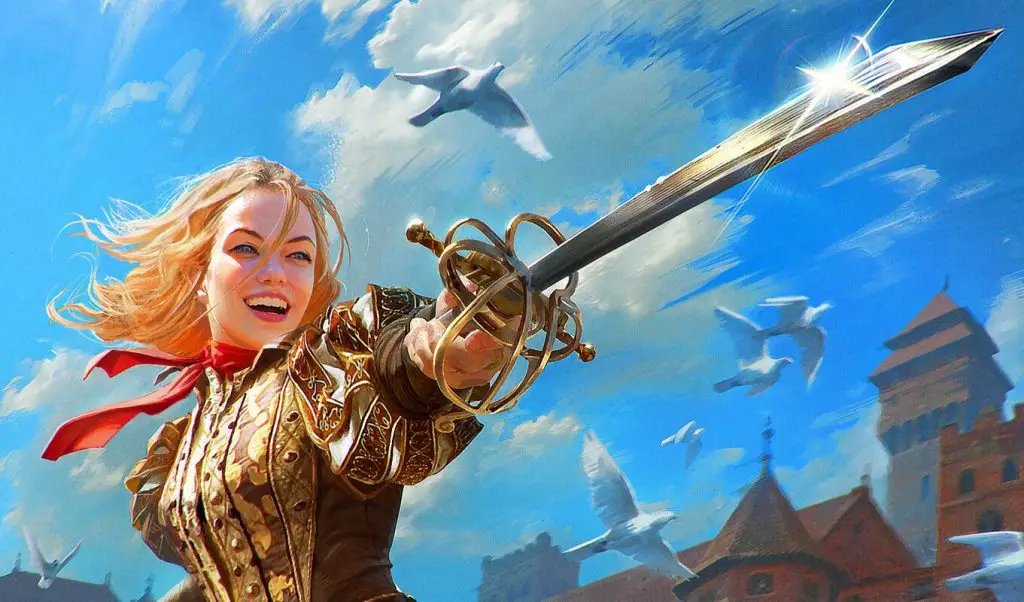
Song of Defense (Level 10)
It really can’t be stressed enough that Wizards are notoriously squishy.
While that’s typically fine if they hang out in the safety of the party’s backlines, that’s not where Bladesingers typically stay.
Even at level 10, a few good hits from an enemy can potentially be all it takes to knock a Bladesinger out cold…
Thankfully, Song of Defense gives you a clever way to use your spell slots defensively!
You can direct your magic to absorb damage while your Bladesong is active.
When you take damage, you can use your reaction to expend one spell slot and reduce that damage to you by an amount equal to five times the spell slot’s level.
This is excellent for helping you stretch your relatively small pool of hit points even further. Not to mention, it can also be extra helpful for helping you maintain concentration on a big spell if you get hit.
However, you don’t want to fall into the trap of relying on this feature too much!
If you’re using this every time you get hit, you will VERY quickly find yourself with no spell slots left. That’s obviously a bit of a problem…
Additionally, be aware that this is using your reaction. This means you won’t be able to make opportunity attacks or cast spells like Counterspell until your reaction resets on your next turn.
You don’t want to ignore this feature, but you do want to make sure that you’re only using this when you really need to.
In most situations, staple defensive spells like Absorb Elements or Shield should be fine for helping you deal with incoming attacks/damage. As level 1 spells, it’s a very small price to pay.
But if that enemy Fire Giant just got fired up and rolled up a critical hit, you’ll be very glad that you have this.
Nobody wants to be on the receiving end of that damage roll, and your spell slots are useless if you get smashed into a puddle of burning goo!
Use ‘em if you got ‘em!
Recommended: Action Economy in D&D 5e Explained
Song of Victory (Level 14)
At level 14, you gain the Bladesinger Wizard’s capstone feature, Song of Victory.
With this feature, you’re getting a nifty boost to your damage output!
You can add your Intelligence modifier (minimum of +1) to the damage of your melee weapon attacks while your Bladesong is active.
There’s certainly no downside to dealing extra damage, so that’s nice. While this won’t be buffing your spell damage, your melee weapon hits will be much more lethal!
You should have at least an 18 Intelligence score (though, ideally, a 20) which means that your melee weapon attacks are dealing an extra 4-5 damage.
Putting it all together, attacks with a rapier would be dealing 1d8 + your DEX + your INT in addition to any other bonuses you have.
Not bad, eh?
Really, the only criticism I have about this feature is that it does come into play pretty late in the game. So, this damage boost won’t necessarily have the level of flash that one might hope for in a capstone feature.
However, if you’ve invested in your Intelligence score, this is a very useful and consistent increase to your melee damage output!
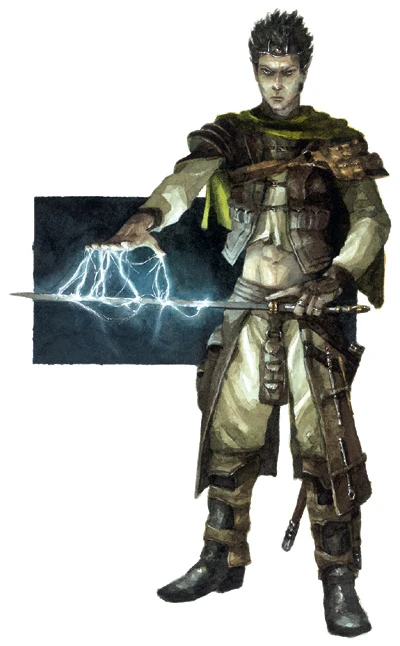
Bladesinger Styles in D&D 5e
As I mentioned earlier in this guide, the Bladesinger Wizard has actually been published twice.
While the version in TCoE is certainly the better of the two, it would be a shame to ignore the extra lore that is mentioned in the subclass’s first appearance in the Sword Coast Adventurer’s Guide.
Specifically, the book mentions three different styles of Bladesinging.
Each Bladesinging style is loosely based on the type of weapons being used as well as what types of spells and tactics they favor in their approach.
Within each category of Bladesinging styles, there are disciplines related to certain animals. For example, the Cat category contains specific styles such as the lion, leopard, and red tiger.
While there isn’t necessarily a mechanical benefit to choosing one or more of these styles, it does offer a lot of unique inspiration for how you might make your character!
Among Bladesinger Wizards, it’s very common to see them proudly wear elaborate tattoos based on which style they practice.
This could be especially cool if tied in with gaining and using magical tattoos to enhance your abilities!
To learn one of these Bladesinging styles is almost certainly to learn from a master of the tradition. Even the newest of these styles is centuries old and calls back to a proud (though highly protected) Elven tradition.
In fact, this greatly opens some interesting roleplaying opportunities between your Bladesinger Wizard and any Monks they encounter.
And, of course, nothing stops you from homebrewing your own Bladesinging style!
Cat
Bladesingers who favor the Cat style focus on using swords. This is generally considered the most famous of the Bladesinger styles and is certainly the most iconic.
There are three styles within Cat Bladesinging: lion, leopard, and red tiger.
The Lion style of Bladesinging is considered to be the oldest form of the tradition. While the longsword is the preferred weapon in this style, there is no particular focus on what types of spells are used.
By contrast, the Leopard style takes a more stealthy approach and favors the use of the shortsword. For spells, Bladesingers who practice this style rely heavily on illusion magic to distract and mislead others.
Lastly, the Red Tiger style of Bladesinging favors using a scimitar with whirling and leaping movements. This style prefers a defensive approach until they get an opening to pounce and strike their foe with everything they have.
Bird
All of the styles of Bird Bladesinging are relatively new and, interestingly, focus on using weapons that aren’t commonly favored by Elves.
For those who favor hafted weapons like axes and hammers, this might be for you.
The two styles within Bird Bladesinging are the Eagle and Raven traditions.
The Eagle Bladesinging style favors the use of small handaxes with no particularly favored type of spells. Specifically, this tradition emphasizes quickly throwing the axes and then readying another for yet another strike.
Note that this approach can get very complicated. If you’re considering this style, you should absolutely check out my guide to using throwing weapons in D&D 5e.
On the other hand, the Raven style prefers to use war picks in combat. For their spell selections, these Bladesingers focus on spells that increase their agility.
Snake
There is one known style of Snake Bladesinging, though its history goes back almost as long as the Lion tradition.
The Viper Bladesinging style emphasizes the use of flails, whips, and chains. Critics might scoff at this style’s perceived lack of elegance, but it’s exactly this kind of unorthodox approach that makes this style so ferocious.
Combined with their quick and swinging strikes, these Bladesingers employ spells that poison, weaken, or otherwise render their foes helpless.
With a rhythmic flurry of intimidating whip cracks, most enemies wisely fear moving close to these warriors during their Bladesong!
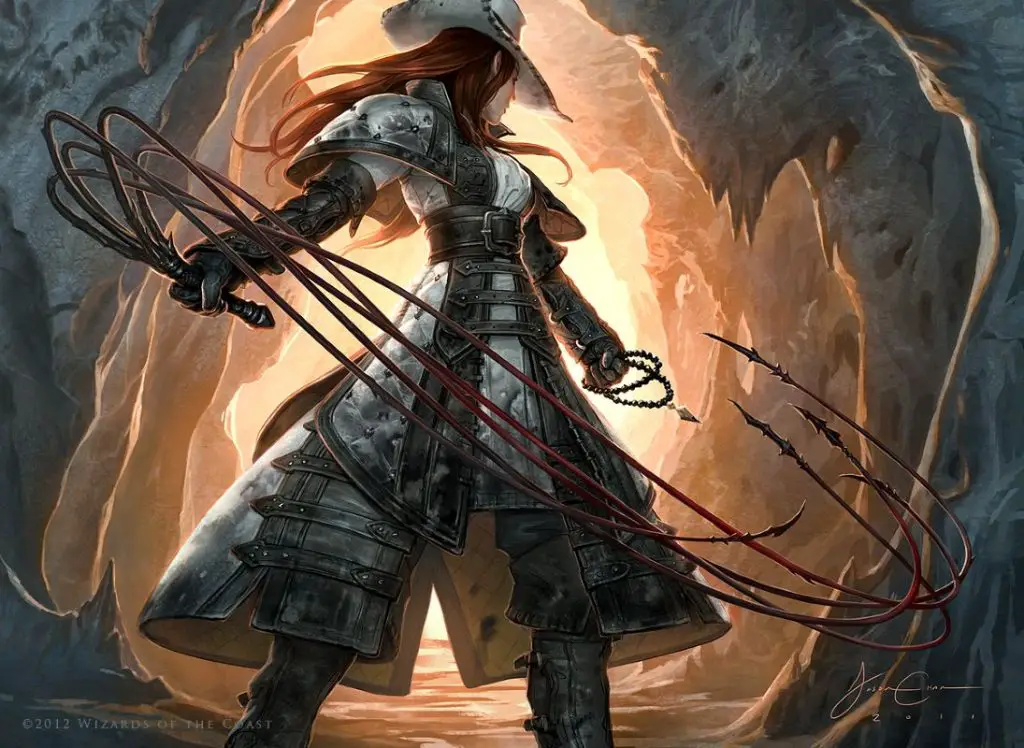
Connections
A colossal amount of the charm of Bladesinging is how uniquely Elven it is. This makes for an interesting opportunity to incorporate connections to Elven culture with your character and the story.
Becoming a Bladesinger is no easy feat, which actually makes it even more remarkable when the tradition is being practiced by a character who doesn’t have the same long life expectancy as Elves.
I mean, an elf might spend a few centuries dedicating themselves to this tradition with few worries. Meanwhile, a human might spend a couple of decades or even less!
So, an Elf Bladesinger Wizard might approach this subclass with a sense of pride, tradition, and heritage.
Meanwhile, a character from a shorter-lived race will likely take a more individualized type of pride in their achievements as they attempt to master this intricate tradition.
Whatever the case, Bladesinger Wizards are often remarkably fearless individuals.
Despite being “squishier” than your typical melee combatants, they trust that their quick reflexes and keen intellect are more than enough to help them stand on the front lines in combat.
While you could very well encounter some Bladesingers in more academic settings, this is less common than most other arcane traditions.
After all, this is a tradition that requires a practical approach and a great deal of hands-on experience to properly learn!
This makes it even more appealing to have a Bladesinger with a kind of military background. They might have been in a “proper” army or, alternatively, they might have been part of a militia defending their elvish home.
Any situation where necessity meets tradition, and the Bladesinger Wizard is able to take an active role in matters, is sure to be a good fit. It’s certainly going to be a story worth telling as well!
Is the Bladesinger Wizard Good?
No doubt, the Bladesinger Wizard is perhaps the most polarizing Wizard subclass in D&D 5e. It could very well be one of the most polarizing subclasses in the entire game!
This is because the Bladesinger really stands out as “a horse of a different color.” Comparing it to the other Wizard subclasses is incredibly difficult because it plays almost entirely differently from any other Wizard!
As I mentioned earlier in this guide, Bladesingers rely on you juggling several key ability scores. Specifically: Intelligence for your spells, Constitution for your hit points and spell concentration, and Dexterity for your melee attacks and armor class.
Combining this MAD (Multiple Ability score Dependence) with the complexity of the Wizard class makes the Bladesinger a fairly difficult option for new players.
This is a subclass that really relies on you having a very solid understanding of how D&D 5e works as a system.
While the subclass is meant to capture the feeling of a character that can expertly combine both swordplay and spellcasting, you’re still a Wizard with a d6 hit die at the end of the day.
Bladesong is a very powerful buff, but you do need to spend your daily uses of it wisely. It’s fittingly the core of what makes this subclass work.
While Bladesingers are certainly cool, I personally think of them more as “Wizards who can also defend themselves in melee combat” rather than characters who should be on the party’s frontlines.
By contrast, the Eldritch Knight Fighter also blends melee combat and spellcasting but in a way that’s less squishy and a bit more beginner-friendly. However, they don’t offer the same huge amount of magical utility that the Bladesinger Wizard does, thanks to the Wizard spell list.
In the hands of a veteran D&D 5e player, the Bladesinger Wizard can bring a lot of value to a party and be a fun experience.
But if you aren’t deeply familiar with the spells of 5e and don’t approach combat and positioning tactically, the experience can quickly become frustrating.
Recommended: Ranking Every Wizard Subclass in D&D 5e!
Conclusion – Bladesinger Wizard in D&D 5e
I hope you’ve found this guide to the Bladesinger Wizard in D&D 5e helpful!
There’s a really fun and exciting concept behind this subclass. It’s little wonder why those who love Bladesingers REALLY love them.
Really, the best Bladesingers are those who know exactly how to tailor their spells and tactics to their party and the situation at hand.
It might sometimes make sense for the Bladesinger to lead a charge. Meanwhile, at other times they are more important for defending the party’s backline.
Few classes reward having a deep familiarity with D&D 5e as a system more than the Bladesinger Wizard. However, this does make it one of the few classes that really aren’t as welcoming to newer players.
But what are your thoughts on the Bladesinger Wizard? Let’s chat in the comments!
Want all the latest player guides, DM tips, news, reviews, and more for D&D 5e? Sign up for the Tabletop Joab newsletter below!
You can also follow me on Facebook and Twitter!
If you found this article helpful and want to support the site, you can buy me a coffee here! (It’s not expected, but very appreciated!)

